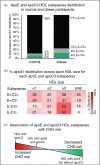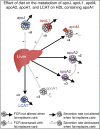Dietary fat and carbohydrate affect the metabolism of protein-based high-density lipoprotein subspecies
- PMID: 34907968
- PMCID: PMC8855953
- DOI: 10.1097/MOL.0000000000000809
Dietary fat and carbohydrate affect the metabolism of protein-based high-density lipoprotein subspecies
Abstract
Purpose of review: Dietary fat compared to carbohydrate increases the plasma concentration of high-density lipoprotein (HDL)-cholesterol. However, neither the mechanism nor its connection to cardiovascular disease is known.
Recent findings: Protein-based subspecies of HDL, especially those containing apolipoprotein E (apoE) or apolipoprotein C3 (apoC3), offer a glimpse of a vast metabolic system related to atherogenicity, coronary heart disease (CHD) and other diseases. ApoE stimulates several processes that define reverse cholesterol transport through HDL, specifically secretion of active HDL subspecies, cholesterol efflux to HDL from macrophages involved in atherogenesis, size enlargement of HDL with cholesterol ester, and rapid clearance from the circulation. Dietary unsaturated fat stimulates the flux of HDL that contains apoE through these protective pathways. Effective reverse cholesterol transport may lessen atherogenesis and prevent disease. In contrast, apoC3 abrogates the benefit of apoE on reverse cholesterol transport, which may account for the association of HDL that contains apoC3 with dyslipidemia, obesity and CHD.
Summary: Dietary unsaturated fat and carbohydrate affect the metabolism of protein-defined HDL subspecies containing apoE or apoC3 accelerating or retarding reverse cholesterol transport, thus demonstrating new mechanisms that may link diet to HDL and to CHD.
Copyright © 2021 Wolters Kluwer Health, Inc. All rights reserved.
Conflict of interest statement
Figures








Similar articles
-
Dietary unsaturated fat increases HDL metabolic pathways involving apoE favorable to reverse cholesterol transport.JCI Insight. 2019 Apr 4;4(7):e124620. doi: 10.1172/jci.insight.124620. eCollection 2019 Apr 4. JCI Insight. 2019. PMID: 30944249 Free PMC article. Clinical Trial.
-
Apolipoproteins E and CIII interact to regulate HDL metabolism and coronary heart disease risk.JCI Insight. 2018 Feb 22;3(4):e98045. doi: 10.1172/jci.insight.98045. eCollection 2018 Feb 22. JCI Insight. 2018. PMID: 29467335 Free PMC article. Clinical Trial.
-
Pharmacological Inhibition of CETP (Cholesteryl Ester Transfer Protein) Increases HDL (High-Density Lipoprotein) That Contains ApoC3 and Other HDL Subspecies Associated With Higher Risk of Coronary Heart Disease.Arterioscler Thromb Vasc Biol. 2022 Feb;42(2):227-237. doi: 10.1161/ATVBAHA.121.317181. Epub 2021 Dec 23. Arterioscler Thromb Vasc Biol. 2022. PMID: 34937388 Free PMC article. Clinical Trial.
-
Associations between Alcohol Consumption and HDL Subspecies Defined by ApoC3, ApoE and ApoJ: the Cardiovascular Health Study.Curr Probl Cardiol. 2023 Jan;48(1):101395. doi: 10.1016/j.cpcardiol.2022.101395. Epub 2022 Sep 10. Curr Probl Cardiol. 2023. PMID: 36096454 Free PMC article. Review.
-
[ApoE-containing HDL and the development of atherosclerosis].Postepy Hig Med Dosw (Online). 2015 Jan 2;69:1-9. doi: 10.5604/17322693.1134724. Postepy Hig Med Dosw (Online). 2015. PMID: 25589708 Review. Polish.
Cited by
-
Understanding HDL Metabolism and Biology Through In Vivo Tracer Kinetics.Arterioscler Thromb Vasc Biol. 2024 Jan;44(1):76-88. doi: 10.1161/ATVBAHA.123.319742. Epub 2023 Nov 30. Arterioscler Thromb Vasc Biol. 2024. PMID: 38031838 Free PMC article. Review.
-
Comparative Evaluation of a Low-Carbohydrate Diet and a Mediterranean Diet in Overweight/Obese Patients with Type 2 Diabetes Mellitus: A 16-Week Intervention Study.Nutrients. 2023 Dec 27;16(1):95. doi: 10.3390/nu16010095. Nutrients. 2023. PMID: 38201924 Free PMC article.
-
The prevalence and clinical correlates of severe anxiety symptoms in first-episode drug-naïve schizophrenia: a Chinese population study.BMC Psychiatry. 2025 Jul 30;25(1):743. doi: 10.1186/s12888-025-07197-1. BMC Psychiatry. 2025. PMID: 40739636 Free PMC article.
-
Comparative Transcriptome Analysis of the Effects of a Non-Insect Artificial Diet on the Nutritional Development of Harmonia axyridis.Insects. 2025 Apr 3;16(4):380. doi: 10.3390/insects16040380. Insects. 2025. PMID: 40332848 Free PMC article.
-
Influence of Fatty Acid Desaturase Enzyme-1 Gene (FADS-1) Polymorphism on Serum Polyunsaturated Fatty Acids Levels, Desaturase Enzymes, Lipid Profile, and Glycemic Control Parameters in Newly Diagnosed Diabetic Mellitus Patients.Int J Mol Sci. 2025 Apr 24;26(9):4015. doi: 10.3390/ijms26094015. Int J Mol Sci. 2025. PMID: 40362254 Free PMC article.
References
-
- Sacks FM, Lichtenstein AH, Wu JHY, et al. . Dietary fats and cardiovascular disease: a presidential advisory from the American Heart Association. Circulation 2017; 136:e1–e23. - PubMed
-
- Mensink RP, Zock PL, Kester AD, Katan MB. Effects of dietary fatty acids and carbohydrates on the ratio of serum total to HDL cholesterol and on serum lipids and apolipoproteins: a meta-analysis of 60 controlled trials. Am J Clin Nutr 2003; 77:1146–1155. - PubMed
-
- Appel LJ, Sacks FM, Carey VJ, et al. . Effects of protein, monounsaturated fat, and carbohydrate intake on blood pressure and serum lipids: results of the OmniHeart randomized trial. JAMA 2005; 294:2455–2464. - PubMed
Publication types
MeSH terms
Substances
Grants and funding
LinkOut - more resources
Full Text Sources
Medical
Research Materials
Miscellaneous

